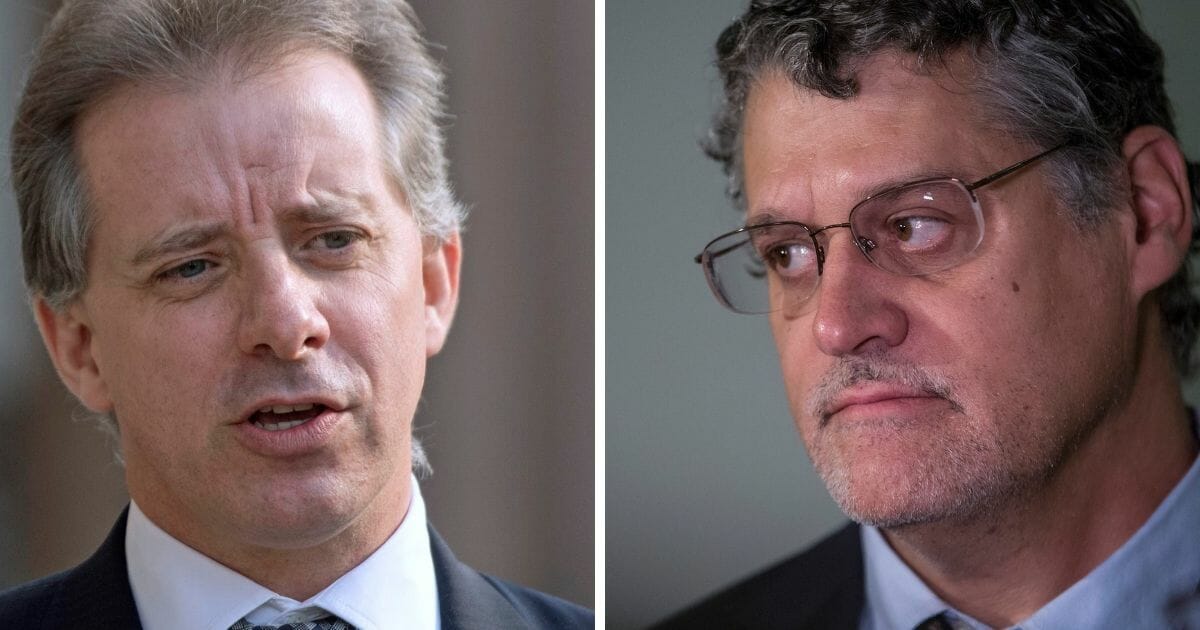
Dossier Architects Claimed They Wanted To Protect Identity of Sources. One Was Unmasked Anyway
Former British spy Christopher Steele and Fusion GPS founder Glenn Simpson claimed to have concerns about the safety and security of one of the sources for the inflammatory “Steele dossier” that threatened to derail the Trump administration in January 2017, but outed the source anyway by talking to journalists.
Steele told a State Department official in October 2016 that “source protection” was a focus in his investigation of then-candidate Donald Trump, according to notes from the meeting released earlier this month.
That purported concern was also shared by Simpson, whose Fusion GPS firm hired Steele on behalf of the Democratic National Committee and the Clinton campaign to perform anti-Trump research work. Simpson told Justice Department official Bruce Ohr on Jan. 20, 2017 — the day Trump was sworn in as president — that he was worried about the safety of a dossier source he believed was about to be identified in the media.
Sergei Millian was outed four days later.
On Jan. 24, 2017, ABC News and The Wall Street Journal identified Millian, an American citizen born in Belarus, as an unwitting source for Steele.
Described interchangeably as Source D, Source E and an “ethnic Russian associate of Trump,” Millian was the source who claimed that the Kremlin was blackmailing Trump with a salacious sex tape and that the Trump campaign had conspired with Russia to influence the election.
Millian’s outing as a dossier source is perhaps an unintended consequence of Steele and Simpson’s contacts with journalists during their investigation of Trump.
As part of its contract with the DNC and Clinton campaign, Fusion GPS was tasked with providing journalists with details of Steele’s investigation. Steele and Simpson briefed numerous journalists and government officials about their investigation before and after the 2016 election, providing some with copies of the dossier. Simpson also acknowledged in Senate testimony in August 2017 that he spoke to reporters about Millian.
Michael Isikoff and David Corn, two journalists who met with Steele before the election, have reported that Simpson tipped off ABC News reporter Brian Ross to Millian’s significance to the Trump investigation in July 2016. Ross, who interviewed Millian on camera on July 29, 2016, would later break the story that Millian was a dossier source.
Millian, who changed his name from Siarhei Kukuts when he came to the U.S., was the subject of several seemingly random news profiles prior to the election. The Daily Beast published a story about him on Sept. 8, 2016. The Financial Times also published a piece on Oct. 31, 2016, titled, “The shadowy émigré touting Trump.”
Until that point, Millian was a virtually unknown businessman who chaired the Russian-American Chamber of Commerce. He had touted Trump in interviews with Russian media and claimed to have worked as a broker for Trump properties in Florida, but he was not viewed as having close ties to Trump or the campaign.
Millian, who has come out of the shadows following the release of special counsel Robert Mueller’s report, noted that he began to receive a sudden flurry of media attention in September 2016. On May 20, he published emails he exchanged at that time with Catherine Belton, the Financial Times reporter who authored the profile of Millian on Oct. 31, 2016.
“For some reason over 20 journalists have called me in the last 3 days,” Millian wrote Belton on Sept. 27, 2016.
Belton also happens to be mentioned in notes from Steele’s meeting at the State Department on Oct. 11, 2016.
Kathleen Kavalec, the State Department official who met with Steele, wrote Belton’s name and that of Jonathan Winer, the State Department official who arranged the Steele meeting, next to the phrase “London meeting.”
Winer, who played a leading role in disseminating Steele’s reports through the State Department, also served as a source for Isikoff and Corn in their own reporting on information from Steele.
While it is not clear whether Steele or someone else tipped Belton off about Millian, she has reported that the Financial Times was provided the dossier before it was published.
Millian would also be the subject of a story published on Jan. 19, 2017, by Mother Jones’ Corn. Like the previous profiles of Millian, the article laid out details of his history, his use of an alias and his purported ties to Trump.
Corn did not identify Millian as a source for the dossier but did suggest that congressional investigators should speak to him.
Millian has long denied being a source for Steele’s report. He has recently said Steele and Simpson falsely identified him in order to distract from the true source, though he has not provided evidence to back up the claim. In the 28 months since he was connected to the dossier, Millian has avoided answering direct questions that might shed light on any of the claims Steele attributed to him.
He did not respond to a request for comment for this article. Fusion GPS and Winer, the former State Department official, also did not respond to requests for comment.
Steele and Simpson have not publicly confirmed that Millian is a source for the dossier. In a Nov. 14, 2017, interview with the House Intelligence Committee, Simpson clammed up when asked if Millian’s information was provided to Steele.
“To your knowledge, was Mr. Millian one of the sources for Christopher Steele in the dossier?” California Democratic Rep. Adam Schiff asked Simpson.
“I’m not in a position to get into the identity of the sources for the dossier for security reasons, primarily,” Simpson said.
In another congressional interview, Simpson acknowledged speaking with journalists about Millian.
“Various reporters became interested in him because he was boasting about his connections to the Trump organization [and] the Trump campaign,” he told the Senate Judiciary Committee on Aug. 22, 2017. “So we got lots of inquiries about who was he, was he a spy, you know, that sort of thing.”
Steele also mentioned Millian in his State Department meeting with Kavelec, who serves as deputy assistant secretary of state for European and Eurasian affairs. Kavalec wrote that Millian was a link between Russia and the Trump campaign, though her notes do not refer to him as a source for information in the dossier.
Kavalec’s notes show that Steele said he was managing four separate issues in his Trump-Russia probe: “Client needs, FBI, Wash Po/NYT, and source protection.”
Steele said that The Washington Post and The New York Times had been given information from his Trump investigation as early as June 2016.
Steele also conveyed concerns about the safety of dossier sources during conversations with Bruce Ohr, the Justice Department official who served as Steele’s liaison to the FBI.
Ohr, whose wife worked as a contractor for Fusion GPS, told Congress in August 2018 that Steele told him at some point in January 2017 that “his source might be outed and in danger.” He said he told the FBI about Steele’s concerns.
Ohr also told lawmakers that during an August 2016 meeting with Simpson, the Fusion GPS founder mentioned Millian as being a possible intermediary between the Trump campaign and Russia. He said that Simpson contacted him on Jan. 20, 2017, with concerns that a source would be identified in the media.
“He was concerned that one of the sources, Chris Steele’s sources, was going to be [ex]posed and that would put the source in personal danger,” Ohr testified on Aug. 28, 2018.
“I think he was aware of some kind of article that was likely to come out in the next, you know, few days or something,” Ohr added.
Though Ohr did not say to whom Simpson was referring, Millian was outed four days later.
Ohr also mentioned Millian’s name in response to a question about Steele’s sources.
When asked how Steele and Fusion GPS attempted to vet information in the dossier, Ohr replied: “The fact that my wife was looking at some of the same figures, like Sergei Millian, suggests that that was one way they were trying to vet the information.”
The special counsel’s report does not mention Millian’s alleged links to the dossier. But he is mentioned because of his relationship to George Papadopoulos, the Trump campaign adviser who is said to have been the catalyst for the FBI’s Russia investigation.
Millian first reached out to Papadopoulos on July 15, 2016, claiming to have “insider knowledge and direct access to the top hierarchy in Russian politics.” They met for the first time on July 30, 2016, a day after Millian’s on-camera interview with ABC News.
Papadopoulos is notably not mentioned in the dossier.
Millian also messaged Papadopoulos on Aug. 23, 2016, with another cryptic offer. According to the special counsel’s report, Millian offered to share with Papadopoulos “a disruptive technology that might be instrumental in your political work for the campaign.”
The special counsel’s office tried to interview Millian, but according to the report, he was out of the country during the investigation and declined repeated interview requests.
Content created by The Daily Caller News Foundation is available without charge to any eligible news publisher that can provide a large audience. For licensing opportunities of our original content, please contact licensing@dailycallernewsfoundation.org.
A version of this article appeared on The Daily Caller News Foundation website.
Truth and Accuracy
We are committed to truth and accuracy in all of our journalism. Read our editorial standards.
Advertise with The Western Journal and reach millions of highly engaged readers, while supporting our work. Advertise Today.












